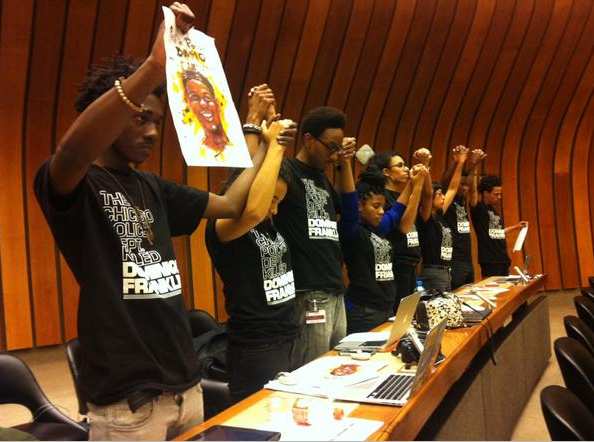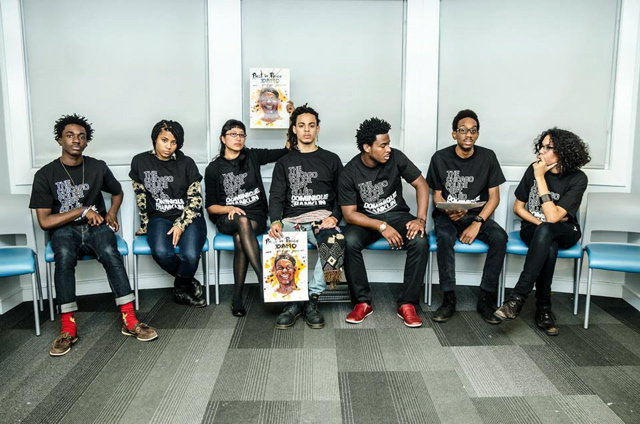Old Town and New History: Youth Delegation on Chicago Police Violence to Report Back from U.N.
By Staff in News on Nov 23, 2014 9:45PM
A 23-year-old with a winning smile, Dominique Franklin Jr. visited a small stretch of North Avenue, between Clark and Sedgwick Sts., familiar to many Chicagoans six months ago.
But he never made it home.
You’ve walked these blocks if you’ve meandered from the Brown or Red lines to North Avenue beach in the summer; caught an exhibit at the Chicago History Museum; or had a drink at the Old Town Ale House, where the extraordinary jazz jukebox can tune out the congregations of drunk white boys typical of a divey North Side scene. Or perhaps you’ve laughed at The Second City, last stop before stardom for many comedians, including Tina Fey, Stephen Colbert, and Steve Carrell.
It is where Dominique ran his last block, out of a Walgreens with an unpaid bottle of vodka. Having snuck away from house arrest, Dominique, like most of us, was no angel—but he was beloved: his father’s namesake, “Damo” to friends.
From the Walgreens, Dominique sprinted west across the front of the massive building housing The Second City. At its edge, two police officers caught up with him, tased him, and tased him again.
After the second tasing, Dominique’s body reportedly went stiff, and he fell hard into the pole in front of him before collapsing onto North Avenue. According to the ambulance report, the 23-year-old laid unassisted in the street for the 15-20 minutes prior to its arrival.
The next day, while in critical condition, police arrested him. Dominique Sr., who has since filed a civil suit against the officers, told the Chicago Tribune he found his son “shackled to his bed.”
Two weeks later, Dominique died.
The stolen Ketel One vodka typically retails for $35. Walgreens ranks 37 among Fortune 500 companies, with $72 billion in sales and a 15 percent increase in profit last year.
Old Town
The blocks mentioned are Old Town blocks, which the City of Chicago acknowledges German immigrants for “settling” by clearing the marshland. The marsh was not a land without people, however, but home and a trade center to the Miami and Pottawatomi, known as “People of the Place of Fire.” Defeated in battle with the US military, they were forced to cede six square miles from the mouth of the Chicago river in 1795.
Today, these blocks neighbor what used to be the northernmost edge of Cabrini-Green, a housing project recently demolished, home to approximately 13,000 predominantly Black Chicagoans at its peak.
Old Town’s previous life is remembered as a community of hippies, part of the showdown between protesters and police during the 1968 Democratic National Convention. But at that time, it was already a battleground, between the Puerto Rican community which called it “La Clark” and Mayor Richard J. Daley’s urban renewal plans.

A 2007 photo of new construction surrounding Cabrini Green. According to the photographer, signs behind the police truck read 'Skyline Views, Could Be Yours. 800 Homes spanning 8 city blocks.'
As Jose “Cha-Cha” Jimenez, one of the Chicago founders of the Young Lords—a radical organization of Puerto Rican youth founded at the time—remembers:
Old Town was carved out from La Clark; but “Old La Clark” was not historically preserved. Instead, a new Old Town was being fantasized and created in City Hall backrooms. Businesses were also using the alleged prosperity of Old Town as a marketing symbol, to develop a domino effect, in order to further kick out Puerto Ricans and the poor, from Lincoln Park.
As part and parcel of their community organizing, the Young Lords contended personally and publicly with police violence. In one of many incidents foreshadowing police shootings in contention today, a 22-year-old Young Lord, Manuel Ramos, was killed by Robert Lamb, a white Chicago police officer in early May 1969.
Historian Judson Jeffries recounts that Lamb entered a party while off-duty “because of the loud music” and shot Ramos twice, citing self-defense after seeing Ramos reach for a weapon—a claim disputed by eyewitness.
Later that month, a jury found the shooting justified.
Disrupting History
Nearly 45 years to the day later, Dominique Franklin Jr. was tased by Chicago police. Six months after that, a delegation of eight young people of color from the organization We Charge Genocide traveled to the United Nations Convention Against Torture in Geneva, Switzerland, to challenge Chicago police violence.

Malcolm London and Asha Ransby-Sporn listen to testimony, with an illustration of Dominique 'Damo' Franklin Jr. by artist Molly Crabapple | Photo via Twitter
They are the friends of Dominique; his friends' friends; young activists of color; and survivors and siblings of police violence. But, in the words of 19-year-old delegate Ethan Viets-Vanlear, they also “represent the mother who drove a young person to a protest...the people locked up in cages right now...Damo and all the other people that are in the ground because of the police.”
They entered the United Nations bearing a meticulously compiled shadow report, We Charge Genocide: Police Violence Against Chicago’s Youth of Color, including statistics on racial disparities in police shootings and tasings; and testimonials from young people across the city. They wore t-shirts and carried posters with Dominique’s name, and testified directly to members of the U.N.

We Charge Genocide delegates stand in silent protest inside the United Nations © We Charge Genocide
By the time the delegates left, they had staged both a walk out and a silent protest inside the United Nations when “US representatives responded to...questions regarding police use of tasers by claiming police are properly trained to use them and that they aren’t lethal,” according to a group statement.
In two days, they changed history. The story of Dominique Franklin Jr. has now been covered around the world, affirming the belief that his life mattered, as all young Black lives matter. Questions of police impunity, militarization, excessive force, and patterns of discrimination are now among the forefront of those posed by U.N. members to the U.S.
The UN just asked the US Gov 'Why do black people not enjoy the same rights as everyone else' @USHRN pic.twitter.com/LBS5jub0NC
— Thenjiwe McHarris (@ThenjiweTM) November 12, 2014Zhang: "Although black people in Chicago only make up 32.3% of the population, why do they account for 75% of arrests?" #UNCAT #WCGtoUN
— Ms. Champion (@SweetTeaBre) November 13, 2014#Belmir #UNCAT - excessive use of force by #police violence in Chicago esp. young black people & during protest and weapons
— USHR Network (@USHRN) November 13, 2014On December 11th, delegates will tell their story live and direct, and speak to future plans for organizing around police violence and accountability in Chicago. “This is not any concluding event, even if the U.N. does agree and try to fix it,” Viets-Vanlear shared in a recent interview.
The Young Lords were fond of saying “Palante, siempre palante,” which translates to “Forward, always forward” in English. Mirroring that spirit, Viets-Vanlear continued, “It doesn’t mean we’re done, it means we’re getting started.”
Co-sponsored by the Mansfield Institute for Social Justice and Transformation, the free event will take place December 11th, from 6 p.m. to 8 pm at Roosevelt University, 430 S. Michigan Ave., 10th Floor.
Sarah Macaraeg is a writer and journalist covering social justice issues via essays, data-based investigations, and oral history. Macaraeg worked with We Charge Genocide in creation of a digital companion to the group’s shadow report. She is currently editing a book of narratives from low wage women workers in Chicago and is on Twitter .
